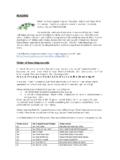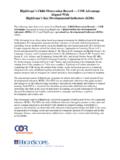Transcription of Instructions thick description - cynthiaclarke.com
1 Overview of assignment requirements: 1) This assignment is a thick description of the field site. 2) Collect field notes from your orientation that inform the reader about the social organization and social structure of the field site. 3) Collect other field notes that reflect a walk-through of the field site as well as other important details from the field site. 4) Collect field notes based on your participant-observations, including paraphrases and quotes from members of the subculture. 5) Conduct a 5-question interview with a key informant who can illuminate the social structure and/or social organization of the subculture. 6) Collect field site data for a chart/graph (CG) to help describe the site; no permission slip required. 7) Using the 5-question interview, the CG, and your field notes provide a description of your field site that is 1,000 words (minimum) in length. Assignment 2: Findings Instructions I. General expectations Your thesis is simply that you are describing the subculture with which you spent time.
2 This assignment asks you to write about the social structure/organization of the subculture and what you observed in the field. II: Entering the field How you joined the subculture o This paper starts with one (1) paragraph where you became a participant in the subculture. o For this paragraph, it is fine to refer to yourself in the 1st person. o Caution: After this paragraph, though, be very careful when you use 1st or 2nd person. Only do so if using 3rd person it sounds awkward or confusing. Explain the mission of the subculture o Write 1-2 paragraphs wherein you explain the main focus of the subculture. o You could start by exploring if the field site generated a website; if they did, paraphrase their mission statement. o Additionally/alternatively: You can collect field notes that reflect verbal statements from the field. You could use an interview question (see below) to identify the mission. III. The field site findings Key term: thick description o thick description is the term used by Clifford Geertz to explain why there is a need to describe the culture, but also to provide the context in which the description is embedded.
3 ASSIGNMENT 2 2 o This resource is an excellent place to explore the concept of thick description . I strongly urge you to read this handout posted by Vanderbilt University Writing Studio. thick description of the field site social structure/social organization o Provide a detailed, thick description of your field site, based on their social structure and social organization. This description is the public face of the organization (the idealized version) of the subculture. Think: How is this subculture SUPPOSED to run? Describe: The social organization, which includes who is in charge, who is doing what, and so forth. [Think of this as the roles .] The social structure, which includes the patterns of interaction, acceptable behaviors, and so forth. [Think of this as the rules .] o Gathering the data: Suggestion: I urge you to explore any booklets, pamphlets, websites, or other sources that would be given to a new volunteer as part of your references. On paper, visualize a walk-through.
4 Option 1: You should include data you learned at your orientation. Option 2: If you did not receive an orientation: Mentally create the orientation you wish you had received. In order to do so, ask questions during your volunteering that inform about the social organization and social structure and/or write questions for Interview 1. This should result in the same information as should have been provided at an orientation. Write these up in your field notes. Do NOT confuse this with using field notes that describe your participant- observation in the field. Use the sketch you developed in the prep to glean ideas of what to write. Use the groups of participants you developed in the prep to glean ideas of what to write. In addition to the sketch and groups of participant page, you should be taking extensive field notes. thick descriptions of the field site interactions o Provide a detailed, thick description of your field site based on your participant-observations: I am looking for you to talk to the reality of the subculture as you observed it, as compared to the ideals expressed by the members of the subculture.
5 By this, I mean you are done with extensive descriptions of the social structure and social organization. Think: How does this subculture REALLY work? Describe: When were the rules and roles observed? When were they broken ? Why? What evidence was there of the values and norms that are important in their subculture. Give examples. o Gathering the data: o Use quotes, paraphrases, stories, academic sources, and other data that help you ASSIGNMENT 2 3 develop this component of the assignment. Voice is paramount in this paper. Glean examples of voice in two ways: The use of voice from Interview 1 o BEFORE you write your interview questions I urge you to use the Assignment 2 prep (the sketch and groups of participants) to highlight what you do NOT know. Make these informational gaps the basis of your interview questions. o Throughout the paper bring in quotes/paraphrases from the interview; these citations may be anywhere in the paper (a minimum of five (5) times).
6 Avoid phrases such as, I interviewed Jones (2016) and he said .. Effective writers use their skill to avoid such blunt phrasings. The use of voice from field notes o These personal communications are in addition to the use of the interview. o I urge you to avoid over-reliance on the voices of officials. o If the person speaking is not an official at the site, use a pseudonym for their name; give them both a first and last name so you can cite correctly. Quantitative data You are asked to include a chart or graph (CG) into this paper. Start by reading these two handouts. They give you guidance on data collection, CG generation, and on formatting considerations. o Guide to Two Most Common CGs (Charts and Graphs) o Chart/Graph (CG) Collection & Formatting into the Paper Special Note: Given you collected the data, or were given them by a representative of the field site, consider them field notes. This means you do not cite in-text or in the References. IV. What to write: Putting it all together Minimums Length of the Entering the field section is not pre-set; determine by content Length of the Findings section is 1,500 (minimum) words.
7 Except for quotes, write this paper in the past tense. There is a grade penalty if you do not. You must describe the social organization and structure of the subculture. You must use your field notes to help describe what you observed in the field (through participant-observation). You must include a CG (chart or graph) as part of the paper and write 2+ paragraphs concerning the CG you included. o The text for the CG should be located in the paper based on where the content fits. In paragraph 1 you should describe the main points of the CG so that the reader can visualize the CG even if s/he could not see it (called CG1 in the grading rubric). In paragraph 2 set the CG into the context of the field site (called CG2 in the grading. o What to write about the CG: Need help writing about a pie chart? Visit: Need help with writing about a column graph? Visit: o Caution: ALWAYS refer to your CG as Figure 1 in your paper. ASSIGNMENT 2 4 You must include paraphrases and/or quotes from your Interview 1 transcript (at least five (5) times).)
8 You must include paraphrases and/or quotes from your field notes (personal communications) (at least five (5) times). Content Start with the Entering the field paragraph Next, provide the description of the mission After that, blend your information on the social structure with the data from your field site participant-observations. o Think about the use of compare and contrast o What was supposed to occur as compared with what did occur. o rubric). This is what I call the so what? factor. Look of the paper Standard formatting is required. You are required to use the information provided in the handout: Standard Formatting of a College Paper as the basis of your formatting. REQUIRED: Use the running header FINDINGS (on left side of header, starting on page 2) and page numbers on the right side, starting on page 2. REQUIRED: Use a section heading, Entering the field, and put the Entering the field and mission paragraphs under this section. REQUIRED: Use a section heading, Findings and put the reminder of the body of the paper under this section.
9 REQUIRED: Refer to the CG as Figure 1 in the text of the paper. [For clarity: Type Figure 1 in bold font, 1st use only] REQUIRED: Mark, using hard brackets, the two paragraphs associated with the chart or graph as CG1 and CG2. [For clarity: Type CG1 and CG2 at the end of the associated paragraph in bold font] REQUIRED: If you use a source from Assignment 1, highlight the associated in-text citation the FIRST time each is cited, using your 1st color. Do not mark subsequent uses for each source. REQUIRED: Highlight the associated in-text citation for each time an Interview 1 paraphrase or quote was used in the paper, using your 2nd color. o Do NOT use page numbers for paraphrases (APA does allow; I find distracting) o DO use page numbers with quotes, so paginate your interview transcript. REQUIRED: When you use personal communications in this paper, highlight each citation in your 3rd color. REQUIRED: In a footnote include the Word Count (Entering the field) = # and the Word Count (Findings) = # Do not count References, footnotes, headings or transcripts in either of these word counts.
10 Special Notes: Remember to cite your interview as an archival source (both in-text and in the References). Remember to cite your personal communications ONLY in-text.







